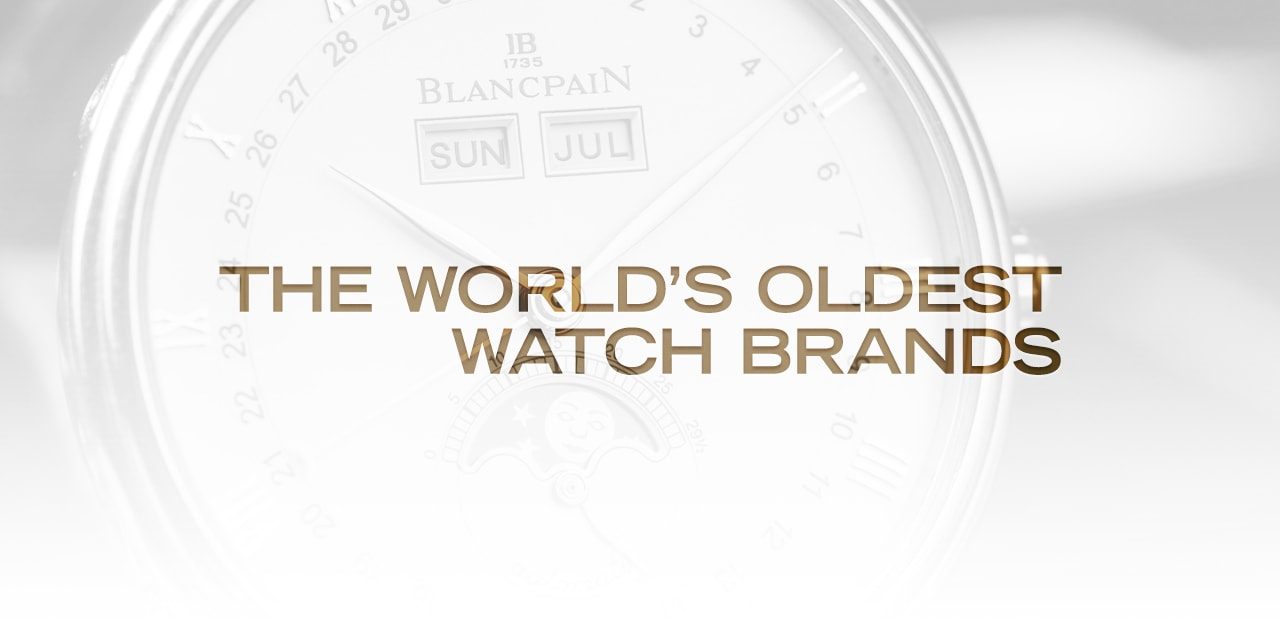The World’s Oldest Watch Brands
You would think it would be an easy enough question to answer; which watchmaker has been around the longest?
However, as if to prove that absolutely nothing is straightforward, as soon as you start delving into it, the question throws up a series of stipulations.
For many of the ‘oldest’ manufactures, what they claim as the date they were established is something we kind of have to take their word for. When you are dealing with brands which can allegedly trace their roots back to the 15th century, it is unavoidable that some of the details will have been lost to the mists of time.
There is also some latitude in the term ‘established’. With several of the very eldest firms, their stated founding year can simply refer to the first time someone with the same family name started working with watches, possibly as a hobby. For example, Gallet is sometimes touted as the oldest clock and watchmaking company in history, having been ‘founded’ in 1466. Yet, the only proof we have of that is a record of a man named Humbertus Gallet becoming a citizen of the Republic of Geneva in that year, his occupation listed as clockmaker and it being assumed he was involved in horology in some fashion. The actual business wasn’t registered until 1826, roughly the same time as they designed their current website.
Similarly with Girard-Perregaux. Their assertion of 1791 is not wholly accurate, as that is merely the year Jean-François Bautte signed his first watches. The company he set up was taken over by his son Jacques Bautte in 1832, which was then acquired in 1906 by the Girard-Perregaux Manufacture, founded by Constant Girard and his wife Marie Perregaux. Regardless of its somewhat ambiguous origins, the brand still uses 1791 as its historic beginnings.
And an extraordinarily small number of firms have managed to go through their entire chronicle completely intact. The vast majority have gone out of business at one point or another, only to be resurrected at a later date. This is why Vacheron Constantin is often thought to be the oldest in the world, as it has enjoyed an uninterrupted run since 1755.
So, in order to keep things fair and on an even keel, for our list we are going to be citing only those manufactures of whose history we can be absolutely sure, using their official date of registration, regardless of whether or not they ceased trading at any point.
Clear as mud? Good, let’s go.
5. Vacheron Constantin (1755)
As we have said, Vacheron holds the record for the oldest, constantly operating watchmaker in the world.
Founded in 1755, what would go on to become one side of the Holy Trinity (alongside Patek Philippe and Audemars Piguet) began life when a 24-year-old Jean-Marc Vacheron hired his first assistant to work with him in his Saint-Gervais studio.
The business was subsequently handed down through generations of the Vacheron family, scoring hatfuls of innovations. The brand can claim the first ever complication when they included a day and date display on a pocket watch in 1790, and they invented the jumping hour hand in 1824.
Jean-Marc’s grandson, Jacques-Barthélémi was the man to team up with wealthy businessman, Francois Constantin in 1819, who then travelled the world marketing their watches.
Over the years, Vacheron Constantin has survived every tumultuous historic event, from as early as the Occupation of Geneva during the French Revolution and, of course, two World Wars. Today, they are renowned for their highly complex and painstakingly finished models, fully living up to their ethos of ‘Do better if possible, and that is always possible.’
4. Ferdinand Berthoud (1753)
Known as one of the fathers of the marine chronometer, Ferdinand Berthoud is one of the greatest horologists of all time, but is a name you may be unfamiliar with.
He opened his first workshop in 1753 at the age of 26, having worked as an apprentice to his clockmaker brother for several years as well as studying the science of horology in Paris.
In 1770 he was named Horologist-Mechanic to both the king and Navy of France, contributing greatly to the development of seafaring navigation, delivering the first ever longitude pocket watch to the Prince of Asturias, the future King Charles IV of Spain.
Berthoud died childless in 1807, the business handing down to his nephew Louis. He, unfortunately, died just six years later, giving the company over to his sons Jean-Louis and Charles-Auguste. When Charles-Auguste died in 1876, the brand disappeared.
Fast forward to 2006 and co-President of Chopard, Karl-Friedrich Scheufele buys the Berthoud name, officially relaunching the brand in 2015. So far, the reawakened manufacture has produced only a tiny collection of handmade, enormously complicated and extremely expensive models. Two of them, however, have won major horology prizes.
One of those under the radar entities, Berthoud is nevertheless a phenomenon—although the jury’s out on their claim to be among the oldest in the world!
3. Jaquet Droz (1738)
Pierre-Jaquet Droz was born on a small farm in La Chaux-de-Fonds in 1721 and started clockmaking at the tender age of 17.
Before long, he was including music and automata (moving mechanical devices, often imitating humans) in his clockworks, which proved extremely popular.
Sadly, Droz lost both his wife and daughter in 1755, after which he devoted himself completely to watchmaking. In 1758, he was able to sell six of his pendulum clocks to King Ferdinand VI of Spain, the generous proceeds of which allowed him to expand his business. His increasingly sophisticated automata captivated aristocracy and royalty from all over Europe and even the emperors and Mandarins of China’s Imperial Court.
The Napoleonic Wars killed off much of the wealth of European nobility, and the company struggled to continue, producing little more than decorative snuff boxes and other trinkets.
In 2000, Jaquet Droz was brought under the Swatch Group umbrella and has reverted back to watchmaking, executing some highly distinctive and spectacular timepieces.
2. Favre-Leuba (1737)
Another name not necessarily recognizable immediately, Favre-Leuba stems from 1737, set up by Abraham Favre in Le Locle in Switzerland. Partnering with Henry-Auguste Leuba in 1815, Favre-Leuba was established.
The company was able to stay in the Favre family for eight generations, expanding into Asia by the start of the 20th century. In the 1950s they built their first in-house movement and started to produce well-received sports and dive watches.
In 1962, they supplied the Swiss National parachute team with their Bivouac model, the first mechanical watch with an aneroid barometer for altimeter and air pressure.
The Quartz Crisis forced the Favre family to sell out in 1985, when it bounced around a few different hands before disappearing completely.
But Titan Company Limited, the watchmaking arm of India’s Tata Group, revived the band in 2011, and they made a triumphant return to Baselworld in 2017.
Today, Favre-Leuba can boast a collection of handsome and robust sports models as well as some keenly-priced dress pieces.
1. Blancpain (1735)
Along with the title of oldest watch brand in the world, pipping Favre by just two years, another of Blancpain’s claims to fame is the introduction of the first automatically winding wristwatch in 1926.
Set up on the top floor of his home in 1735 by Jehan-Jacques Blancpain who, as well as being a watchmaker, was also a schoolteacher and cattle breeder. By the end of the century, Blancpain had progressed from simply making components for other brands’ watches to building complete pieces of his own.
The company stayed in the Blancpain family for over two centuries before it was handed over to a long-term associate, Betty Fiechter, the first female CEO of a leading watch brand.
Perhaps the manufacture’s most famous creation came along in the 1950s when they released the Fifty Fathoms, thought of today as the original modern dive watch, beating Rolex’s Submariner to the punch by mere months.
Again, the Quartz Crisis hit hard, forcing a sale to what would become Swatch in 1992. Now, though, they thrive in rude health—a partner and sponsor of Lamborghini and creator of some of the finest high end luxury watches in the world.
Featured Photo: Pexels (cc) Archive.







